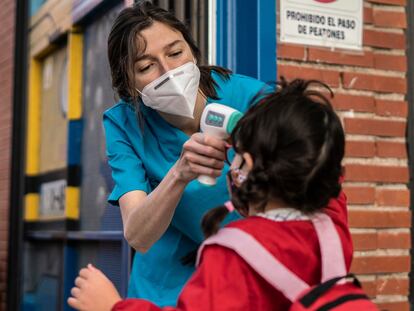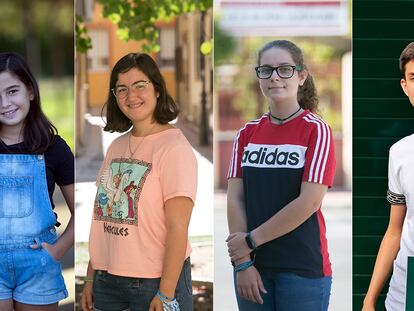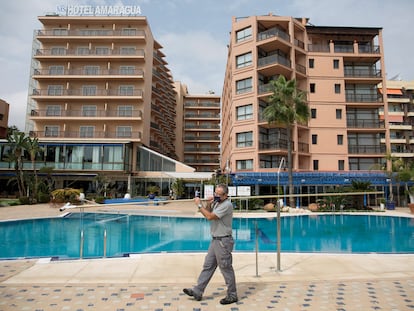Nearly 3,000 classes in Spain forced to quarantine since beginning of school year
The number represents just 1% of the total, but has led to problems for thousands of families struggling to balance work with looking after children in isolation

The coronavirus has forced students of all ages from 2,852 classrooms across Spain to go into quarantine since the beginning of the school year, according to data provided by regional authorities to the Education Ministry. This represents less than 1% of the total, but the percentage of affected classes varies greatly between Spain’s 17 regions. Education authorities say that the number of classes in quarantine is at a manageable level where schools can continue to operate relatively normally, given the exceptional circumstances caused by the Covid-19 pandemic.
But the confinement of classes is a serious problem for thousands of families. Only a few regions have responded to EL PAÍS’s questions about how many students have been affected, and the Education Ministry has not yet offered a total figure. But if an average class has 15 students, which is a conservative estimate, it means that more than 40,000 students have been quarantined since the beginning of the school year. This includes pupils of all ages, including teenagers who can stay home alone and study remotely with relative guarantees of success. But many other students are small children who need to be looked after by a parent or adult during their isolation period. This has led to difficulties with parents’ work and sparked concerns about the impact of quarantines on children’s education.
I am also worried about my daughter’s education, especially since I think this is going to happen againCarme Domènech, mother of six-year-old in quarantine
“In my case, it has been disruptive because both of us work,” says Carme Domènech, the mother of a six-year-old student at a public school in Valencia who has been in quarantine since Wednesday. “I work remotely and my husband has the afternoon shift, so only part of my working day is affected, when I have to juggle my job with my role as mother.”
While Domènech says that she is much less productive because of the situation, she recognizes that “there are worse cases in the class,” such as parents who have to work in offices and do not know whether they can ask for sick leave. “And I am also worried about my daughter’s education, especially since I think this is going to happen again and this will not be a normal school year,” says Domènech, who works as an accountant.

First quarantined classes return to school
Regional authorities believe that the number of classes in quarantine is at a reasonable level. In some regions, such as Navarre and Aragón, authorities point out that classes that were placed in isolation when schools first reopened have now begun to return. Others, such as the Basque Country, say the rate of quarantined classes has slowed down. And in general, education authorities say the goal is still to maintain the greatest number of face-to--face classes possible. This is despite the fact that restrictions may be introduced in other social contexts if the virus continues to spread.
Based on available information, which has largely come from other countries that reopened schools before summer or at the beginning of August, public health experts such as Salvador Peiró believe that schools are unlikely to be major hotspots for transmission. But schools are not islands, and if a region has a high transmission rate, this is likely to be reflected in its schools, explains Peiró, who is a member of Fisabio, a health research foundation run by the regional government of Valencia. This could make it difficult for schools to continue the normal academic year as planned. For example, the Madrid region, which has the highest incidence rate of Covid-19 in Spain, also has the highest number of classes in quarantine since the beginning of the school year. Last Friday, 168 classes were in isolation, a figure that jumped to 832 on Wednesday.
Differences between the regions
EL PAÍS asked regional authorities for the number of classes that have been quarantined since schools reopened. Only 13 replied. None of them specified the age of the students, and only a few of them indicated the number of affected classes as a percentage of the total. In Madrid, 832 classes have been quarantined (1.4% of the total) since students returned to school. The region with the second-highest number of quarantined classes is Catalonia with 602, followed by the Basque Country (268, 1.5%), Castilla-La Mancha (180, 1%), Andalusia (168, 0.2%), Aragón (148, 1.7%), Navarre (142), Castilla y León (141, 1%), Valencia (130, 0.3%), Extremadura (73), the Balearic Islands (49, 0.7%), La Rioja (33) and Galicia (27).
The difference is a reflection of several factors. First, the transmission rate of the disease varies greatly between the regions: in Madrid, the 14-day cumulative incidence of Covid-19 was 742.6 cases per 100,000 inhabitants, compared to 114.4 in Galicia, according to Tuesday’s epidemiological report. Secondly, some regions delayed the start of the school year, with some classes returning up to two weeks later than others. And lastly, some regions update their figures every day while others do so every week: in Andalusia and Valencia, for example, the latest figures are from Monday.
Regional authorities in the Canary Islands, Asturias and Cantabria did not reply to EL PAÍS’s request. Murcia only offered the number of students and teachers in quarantine, 187 and 43 respectively, but not the number of classes. In the case of Madrid, unions argue that transmission rates in schools are higher than what is being reported by the regional government in the official statistics.
English version by Melissa Kitson.
Tu suscripción se está usando en otro dispositivo
¿Quieres añadir otro usuario a tu suscripción?
Si continúas leyendo en este dispositivo, no se podrá leer en el otro.
FlechaTu suscripción se está usando en otro dispositivo y solo puedes acceder a EL PAÍS desde un dispositivo a la vez.
Si quieres compartir tu cuenta, cambia tu suscripción a la modalidad Premium, así podrás añadir otro usuario. Cada uno accederá con su propia cuenta de email, lo que os permitirá personalizar vuestra experiencia en EL PAÍS.
¿Tienes una suscripción de empresa? Accede aquí para contratar más cuentas.
En el caso de no saber quién está usando tu cuenta, te recomendamos cambiar tu contraseña aquí.
Si decides continuar compartiendo tu cuenta, este mensaje se mostrará en tu dispositivo y en el de la otra persona que está usando tu cuenta de forma indefinida, afectando a tu experiencia de lectura. Puedes consultar aquí los términos y condiciones de la suscripción digital.
More information
Últimas noticias
Most viewed
- Reinhard Genzel, Nobel laureate in physics: ‘One-minute videos will never give you the truth’
- Oona Chaplin: ‘I told James Cameron that I was living in a treehouse and starting a permaculture project with a friend’
- Pablo Escobar’s hippos: A serious environmental problem, 40 years on
- Charles Dubouloz, mountaineering star, retires at 36 with a farewell tour inspired by Walter Bonatti
- Why we lost the habit of sleeping in two segments and how that changed our sense of time











































